2011 SUBARU IMPREZA WRX tire pressure
[x] Cancel search: tire pressurePage 435 of 458
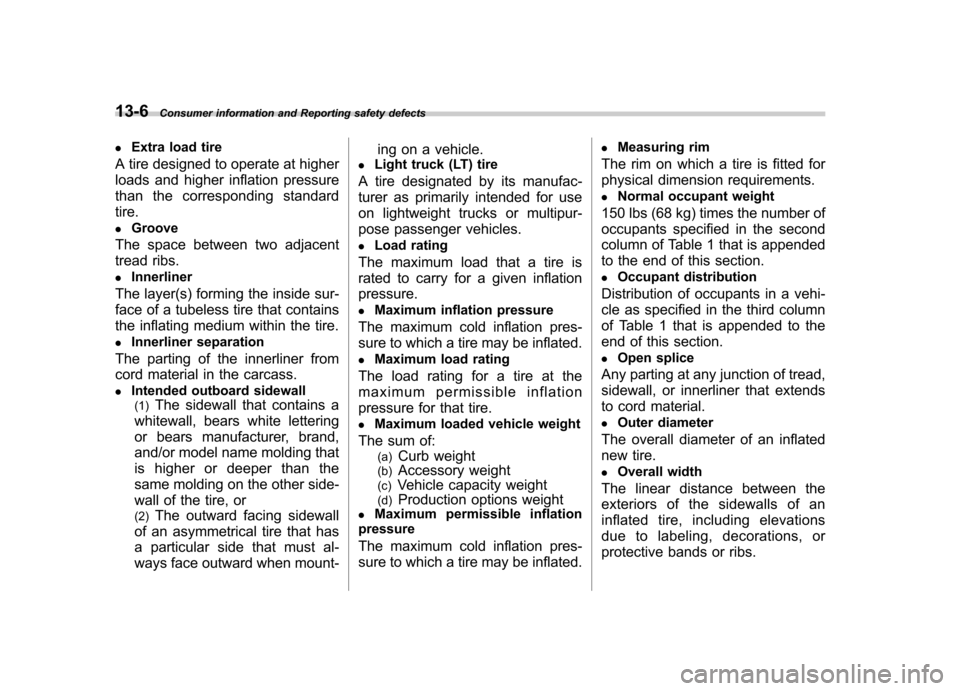
13-6Consumer information and Reporting safety defects
. Extra load tire
A tire designed to operate at higher
loads and higher inflation pressure
than the corresponding standardtire. . Groove
The space between two adjacent
tread ribs.. Innerliner
The layer(s) forming the inside sur-
face of a tubeless tire that contains
the inflating medium within the tire. . Innerliner separation
The parting of the innerliner from
cord material in the carcass.. Intended outboard sidewall
(1) The sidewall that contains a
whitewall, bears white lettering
or bears manufacturer, brand,
and/or model name molding that
is higher or deeper than the
same molding on the other side-
wall of the tire, or (2) The outward facing sidewall
of an asymmetrical tire that has
a particular side that must al-
ways face outward when mount- ing on a vehicle.
. Light truck (LT) tire
A tire designated by its manufac-
turer as primarily intended for use
on lightweight trucks or multipur-
pose passenger vehicles. . Load rating
The maximum load that a tire is
rated to carry for a given inflationpressure.. Maximum inflation pressure
The maximum cold inflation pres-
sure to which a tire may be inflated.. Maximum load rating
The load rating for a tire at the
maximum permissible inflation
pressure for that tire.. Maximum loaded vehicle weight
The sum of: (a) Curb weight
(b) Accessory weight
(c) Vehicle capacity weight
(d) Production options weight
. Maximum permissible inflation
pressure
The maximum cold inflation pres-
sure to which a tire may be inflated. .
Measuring rim
The rim on which a tire is fitted for
physical dimension requirements. . Normal occupant weight
150 lbs (68 kg) times the number of
occupants specified in the second
column of Table 1 that is appended
to the end of this section. . Occupant distribution
Distribution of occupants in a vehi-
cle as specified in the third column
of Table 1 that is appended to the
end of this section. . Open splice
Any parting at any junction of tread,
sidewall, or innerliner that extends
to cord material. . Outer diameter
The overall diameter of an inflated
new tire.. Overall width
The linear distance between the
exteriors of the sidewalls of an
inflated tire, including elevations
due to labeling, decorations, or
protective bands or ribs.
Page 436 of 458
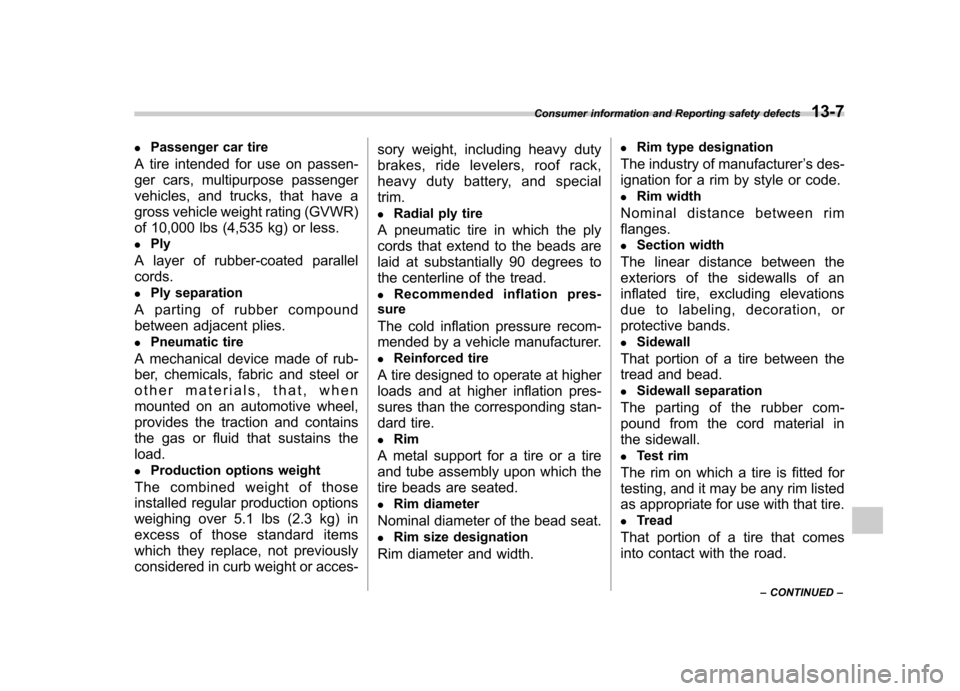
.Passenger car tire
A tire intended for use on passen-
ger cars, multipurpose passenger
vehicles, and trucks, that have a
gross vehicle weight rating (GVWR)
of 10,000 lbs (4,535 kg) or less. . Ply
A layer of rubber-coated parallel cords.. Ply separation
A parting of rubber compound
between adjacent plies.. Pneumatic tire
A mechanical device made of rub-
ber, chemicals, fabric and steel or
other materials, that, when
mounted on an automotive wheel,
provides the traction and contains
the gas or fluid that sustains theload. . Production options weight
The combined weight of those
installed regular production options
weighing over 5.1 lbs (2.3 kg) in
excess of those standard items
which they replace, not previously
considered in curb weight or acces- sory weight, including heavy duty
brakes, ride levelers, roof rack,
heavy duty battery, and special trim.
. Radial ply tire
A pneumatic tire in which the ply
cords that extend to the beads are
laid at substantially 90 degrees to
the centerline of the tread. . Recommended inflation pres-
sure
The cold inflation pressure recom-
mended by a vehicle manufacturer. . Reinforced tire
A tire designed to operate at higher
loads and at higher inflation pres-
sures than the corresponding stan-
dard tire. . Rim
A metal support for a tire or a tire
and tube assembly upon which the
tire beads are seated. . Rim diameter
Nominal diameter of the bead seat. . Rim size designation
Rim diameter and width. .
Rim type designation
The industry of manufacturer ’s des-
ignation for a rim by style or code. . Rim width
Nominal distance between rim flanges. . Section width
The linear distance between the
exteriors of the sidewalls of an
inflated tire, excluding elevations
due to labeling, decoration, or
protective bands. . Sidewall
That portion of a tire between the
tread and bead.. Sidewall separation
The parting of the rubber com-
pound from the cord material in
the sidewall.. Test rim
The rim on which a tire is fitted for
testing, and it may be any rim listed
as appropriate for use with that tire.. Tread
That portion of a tire that comes
into contact with the road.
Consumer information and Reporting safety defects
13-7
– CONTINUED –
Page 439 of 458
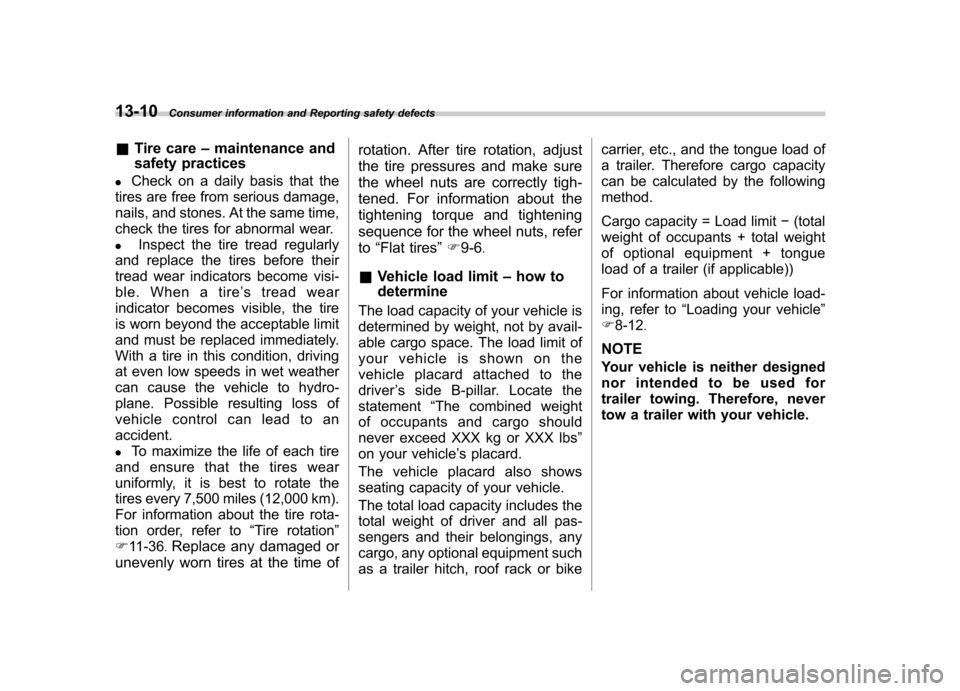
13-10Consumer information and Reporting safety defects
& Tire care –maintenance and
safety practices
. Check on a daily basis that the
tires are free from serious damage,
nails, and stones. At the same time,
check the tires for abnormal wear. . Inspect the tire tread regularly
and replace the tires before their
tread wear indicators become visi-
ble. When a tire ’streadwear
indicator becomes visible, the tire
is worn beyond the acceptable limit
and must be replaced immediately.
With a tire in this condition, driving
at even low speeds in wet weather
can cause the vehicle to hydro-
plane. Possible resulting loss of
vehiclecontrolcanleadtoanaccident. . To maximize the life of each tire
and ensure that the tires wear
uniformly, it is best to rotate the
tires every 7,500 miles (12,000 km).
For information about the tire rota-
tion order, refer to “Tire rotation ”
F 11-36 .
Replace any damaged or
unevenly worn tires at the time of rotation. After tire rotation, adjust
the tire pressures and make sure
the wheel nuts are correctly tigh-
tened. For information about the
tightening torque and tightening
sequence for the wheel nuts, refer to
“Flat tires ”F 9-6 .
& Vehicle load limit –how to
determine
The load capacity of your vehicle is
determined by weight, not by avail-
able cargo space. The load limit of
your vehicle is shown on the
vehicle placard attached to the
driver ’s side B-pillar. Locate the
statement “The combined weight
of occupants and cargo should
never exceed XXX kg or XXX lbs ”
on your vehicle ’s placard.
Thevehicleplacardalsoshows
seating capacity of your vehicle.
The total load capacity includes the
total weight of driver and all pas-
sengers and their belongings, any
cargo, any optional equipment such
as a trailer hitch, roof rack or bike carrier, etc., and the tongue load of
a trailer. Therefore cargo capacity
can be calculated by the following method.
Cargo capacity = Load limit
�(total
weight of occupants + total weight
of optional equipment + tongue
load of a trailer (if applicable))
For information about vehicle load-
ing, refer to “Loading your vehicle ”
F 8-12 .
NOTE
Your vehicle is neither designed
nor intended to be used for
trailer towing. Therefore, never
tow a trailer with your vehicle.
Page 452 of 458
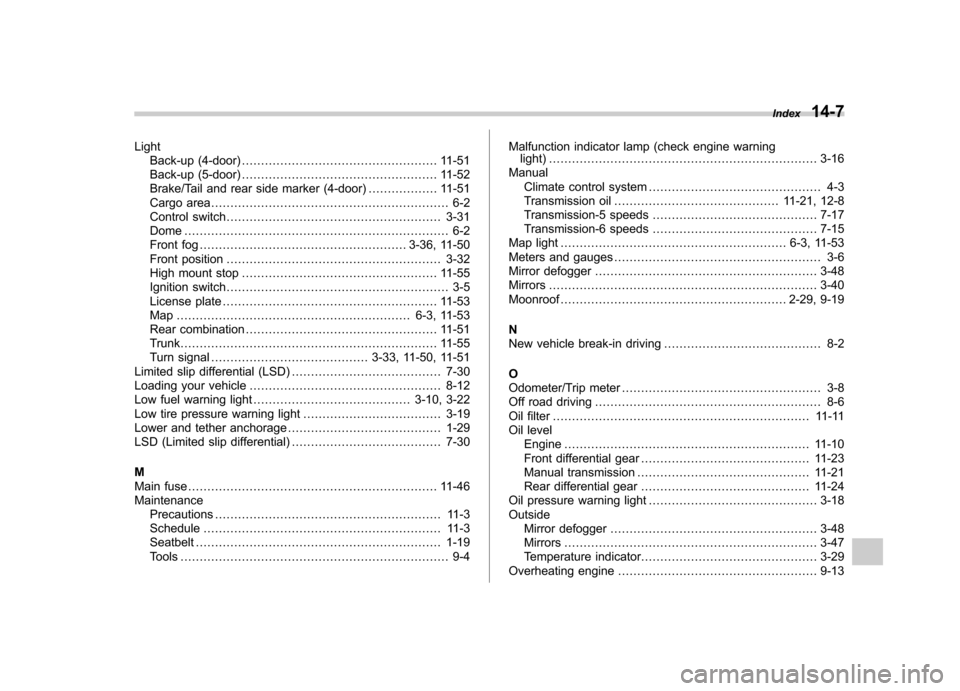
LightBack-up (4-door) ................................................... 11-51
Back-up (5-door) ................................................... 11-52
Brake/Tail and rear side marker (4-door) .................. 11-51
Cargo area .............................................................. 6-2
Control switch ........................................................ 3-31
Dome ..................................................................... 6-2
Front fog ...................................................... 3-36, 11-50
Front position ........................................................ 3-32
High mount stop ................................................... 11-55
Ignition switch .......................................................... 3-5
License plate ........................................................ 11-53
Map ............................................................. 6-3, 11-53
Rear combination .................................................. 11-51
Trunk ................................................................... 11-55
Turn signal ......................................... 3-33, 11-50, 11-51
Limited slip differential (LSD) ....................................... 7-30
Loading your vehicle .................................................. 8-12
Low fuel warning light ......................................... 3-10, 3-22
Low tire pressure warning light .................................... 3-19
Lower and tether anchorage ........................................ 1-29
LSD (Limited slip differential) ....................................... 7-30
M
Main fuse ................................................................. 11-46
Maintenance
Precautions ........................................................... 11-3
Schedule .............................................................. 11-3
Seatbelt ................................................................ 1-19
Tools ...................................................................... 9-4 Malfunction indicator lamp (check engine warning
light) ...................................................................... 3-16
Manual
Climate control system ............................................. 4-3
Transmission oil ........................................... 11-21, 12-8
Transmission-5 speeds ........................................... 7-17
Transmission-6 speeds ........................................... 7-15
Map light ........................................................... 6-3, 11-53
Meters and gauges ...................................................... 3-6
Mirror defogger .......................................................... 3-48
Mirrors ...................................................................... 3-40
Moonroof ........................................................... 2-29, 9-19
N
New vehicle break-in driving ......................................... 8-2
O
Odometer/Trip meter .................................................... 3-8
Off road driving ........................................................... 8-6
Oil filter ................................................................... 11-11
Oil level
Engine ................................................................ 11-10
Front differential gear ............................................ 11-23
Manual transmission ............................................. 11-21
Rear differential gear ............................................ 11-24
Oil pressure warning light ............................................ 3-18
Outside Mirror defogger ...................................................... 3-48
Mirrors .................................................................. 3-47
Temperature indicator .............................................. 3-29
Overheating engine .................................................... 9-13 Index
14-7
Page 455 of 458
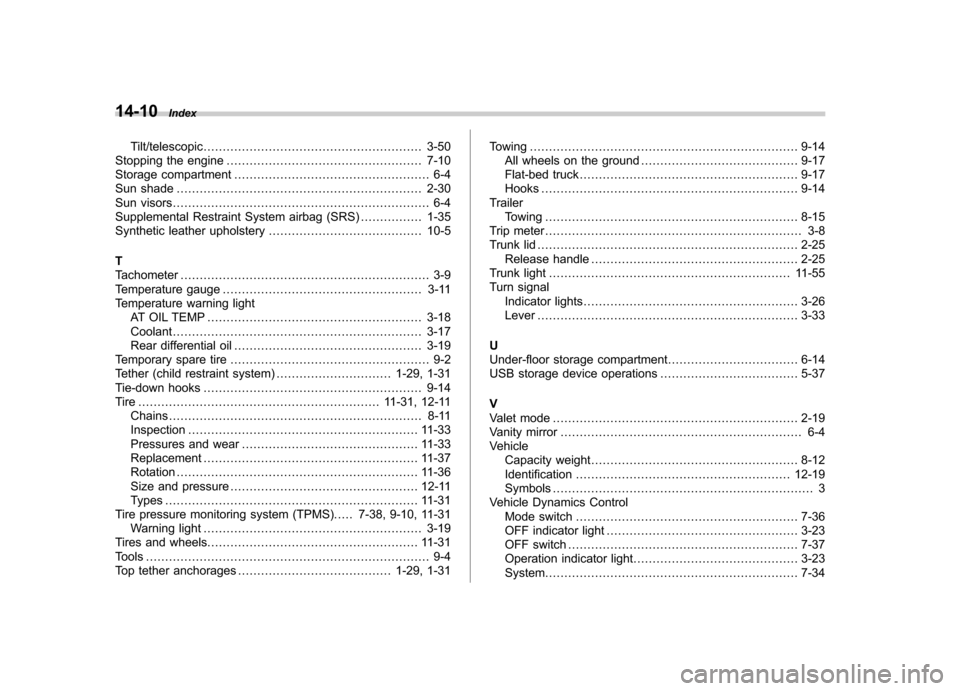
14-10Index
Tilt/telescopic ......................................................... 3-50
Stopping the engine ................................................... 7-10
Storage compartment ................................................... 6-4
Sun shade ................................................................ 2-30
Sun visors ................................................................... 6-4
Supplemental Restraint System airbag (SRS) ................ 1-35
Synthetic leather upholstery ........................................ 10-5
T
Tachometer ................................................................. 3-9
Temperature gauge .................................................... 3-11
Temperature warning light AT OIL TEMP ........................................................ 3-18
Coolant ................................................................. 3-17
Rear differential oil ................................................. 3-19
Temporary spare tire .................................................... 9-2
Tether (child restraint system) .............................. 1-29, 1-31
Tie-down hooks ......................................................... 9-14
Tire ............................................................... 11-31, 12-11
Chains .................................................................. 8-11
Inspection ............................................................ 11-33
Pressures and wear .............................................. 11-33
Replacement ........................................................ 11-37
Rotation ............................................................... 11-36
Size and pressure ................................................. 12-11
Types .................................................................. 11-31
Tire pressure monitoring system (TPMS). .... 7-38, 9-10, 11-31
Warning light ......................................................... 3-19
Tires and wheels. ...................................................... 11-31
Tools .......................................................................... 9-4
Top tether anchorages ........................................ 1-29, 1-31 Towing
...................................................................... 9-14
All wheels on the ground ......................................... 9-17
Flat-bed truck ......................................................... 9-17
Hooks ................................................................... 9-14
Trailer Towing .................................................................. 8-15
Trip meter ................................................................... 3-8
Trunk lid .................................................................... 2-25
Release handle ...................................................... 2-25
Trunk light ............................................................... 11-55
Turn signal
Indicator lights ........................................................ 3-26
Lever .................................................................... 3-33
U
Under-floor storage compartment .................................. 6-14
USB storage device operations .................................... 5-37
V
Valet mode ................................................................ 2-19
Vanity mirror ............................................................... 6-4
Vehicle Capacity weight ...................................................... 8-12
Identification ........................................................ 12-19
Symbols .................................................................... 3
Vehicle Dynamics Control
Mode switch .......................................................... 7-36
OFF indicator light .................................................. 3-23
OFF switch ............................................................ 7-37
Operation indicator light ........................................... 3-23
System .................................................................. 7-34
Page 456 of 458

Warning light......................................................... 3-23
Ventilator .................................................................... 4-2
W
Warning and indicator lights ........................................ 3-13
Warning light ABS ..................................................................... 3-21
All-Wheel Drive ...................................................... 3-23
AT OIL TEMP ........................................................ 3-18
Brake system ........................................................ 3-21
Charge ................................................................. 3-18
CHECK ENGINE ................................................... 3-16
Coolant temperature high ........................................ 3-17
Door open ............................................................. 3-23
Driver ’s Control Center Differential ........................... 3-28
Hill start assist ....................................................... 3-22
Low fuel ........................................................ 3-10, 3-22
Low tire pressure ................................................... 3-19
Oil pressure .......................................................... 3-18
Rear differential oil temperature ............................... 3-19
Seatbelt ................................................................ 3-14
SRS airbag system ................................................ 3-15
Vehicle Dynamics Control ....................................... 3-23
Warranties ..................................................................... 1
Washing ................................................................... 10-2
Waxing and polishing ................................................. 10-3
Wear indicators ......................................................... 11-35
Wheel Alignment ............................................................. 12-11
Aluminum ............................................................. 11-38
Balance ............................................................... 11-35 Nut tightening torque
....................................... 9-6, 12-11
Replacement. ....................................................... 11-37
Windows ................................................................... 2-21
Windshield Washer fluid. ........................................................ 11-38
Wiper and washer switches ..................................... 3-38
Wiper blades ........................................................ 11-40
Wiper deicer .......................................................... 3-48
Winter
Driving ................................................................... 8-8
Tires ........................................................... 8-10, 11-31
Wiper and washer ...................................................... 3-36
Wiper deicer .............................................................. 3-48 Index
14-11
Page 458 of 458

GAS STATION REFERENCE
& Fuel:
! Non-turbo models
Use only unleaded gasoline with an octane rating of 87 AKI
(90 RON) or higher .
! Turbo models except STI
Use premium unleaded gasoline with an octane rating of 91
AKI (95 RON) or higher . If premium unleaded gasoline with an
octane rating of 91 AKI (95 RON) is not available, regular
unleaded gasoline with octane rating of 87 AKI (90 RON) or
higher may be temporarily used. For optimum engine perfor-
mance and driveability, it is required that you use premium
grade unleaded gasoline with an octane rating of 91 AKI (95
RON) or higher. ! STI
The engine is designed to operate at maximum performance using unleaded gasoline with an octane rating of 93 AKI (98
RON) or higher . If 93 AKI (98 RON) fuel is not readily available
in your area, unleaded gasoline with an octane rating of 91 AKI
(95 RON) may be used with no detriment to engine durability or
driveability. However, you may notice a slight decrease in
maximum engine performance while using 91 AKI (95 RON)
fuel. Use of 91 AKI (95 RON) fuel will not affect your warrantycoverage. &
Fuel octane rating:
This octane rating is the average of the Research Octane and
Motor Octane numbers and is commonly referred to as the Anti
Knock Index (AKI). Refer to “Fuel octane rating ”F 7-3.
& Fuel capacity:
16.9 US gal (64 liters, 14.1 Imp gal) & Engine oil:
Use SUBARU approved motor oil or equivalent.
For the details, refer to “Engine oil ”F 12-5.
& Engine oil capacity:
4.4 US qt (4.2 liters, 3.7 Imp qt) & Cold tire pressure:
Refer to “Tires ”F 12-11.